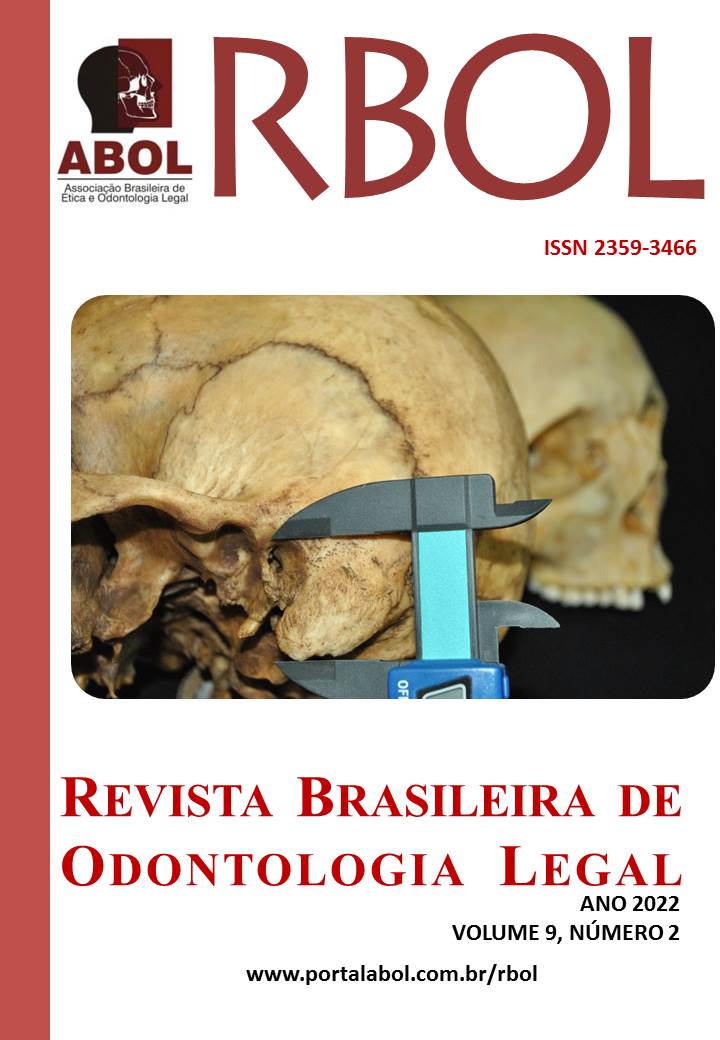ANÁLISE DAS CARACTERÍSTICAS E VIABILIDADE DE AMOSTRAS QUESTIONADAS DE TECIDOS RÍGIDOS SUBMETIDAS A EXAME DE DNA FORENSE
DOI:
https://doi.org/10.21117/rbol-v9n22022-423Keywords:
genética forense; dna; odontologia legalAbstract
This study aimed to trace and analyze the profile of DNA tests extracted from samples of hard tissues, performed by the Forensic Genetics Institute located in Recife-PE, during the period from January to December 2020. Characterized by being cross-sectional, with a quantitative and descriptive approach, it used secondary data extracted from the Institute's spreadsheets, with which it built a database, later analyzed. The results showed that bones and teeth are collected as samples for DNA testing, representing the percentage of 47.4% of all exams received in the year 2020, with 99.5% coming from crimes against life. Among the samples obtained from hard tissue, 42% had its processing completed (39.1% for teeth and 42.6% for bones), 10% were not completed (17.2% for teeth and 8.5% for bones), and 48% were listed as not informed. All tooth-composite samples didn´t specify the tooth classification. Bone samples corresponded to unspecified bone fragments in 81% of the cases, 13.4% were femur fragments, and the remaining percentage was distributed among fragments of clavicle, skull, scapula, femur, manubrium, long bone, tibia, vertebra, sternum bone, mandible, and ulna, ranging from 1-2% for each. Therefore, it can be concluded that the profile of DNA tests extracted from hard tissue samples at the researched institute is composed of bones and teeth, being mostly bone fragments of various types, especially femur, and a better qualification of the sample types used for extraction is needed.
Downloads
Published
Issue
Section
License
Os autores deverão encaminhar por email, devidamente assinada pelos autores ou pelo autor responsável pelo trabalho, a declaração de responsabilidade e transferência de direitos autorais para a RBOL, conforme modelo abaixo.
DECLARAÇÃO DE RESPONSABILIDADE E TRANSFERÊNCIA DE DIREITOS AUTORAIS
Eu (Nós), listar os nomes completos dos autores, transfiro(rimos) todos os direitos autorais do artigo intitulado: colocar o título à Revista Brasileira de Odontologia Legal - RBOL.
Declaro(amos) que o trabalho mencionado é original, não é resultante de plágio, que não foi publicado e não está sendo considerado para publicação em outra revista, quer seja no formato impresso ou no eletrônico.
Declaro(amos) que o presente trabalho não apresenta conflitos de interesse pessoais, empresariais ou governamentais que poderiam comprometer a obtenção e divulgação dos resultados bem como a discussão e conclusão do estudo.
Declaro(amos) que o presente trabalho foi totalmente custeado por seus autores. Em caso de financiamento, identificar qual a empresa, governo ou agência financiadora.
Local, data, mês e ano.
Nome e assinatura do autor responsável (ou de todos os autores).

